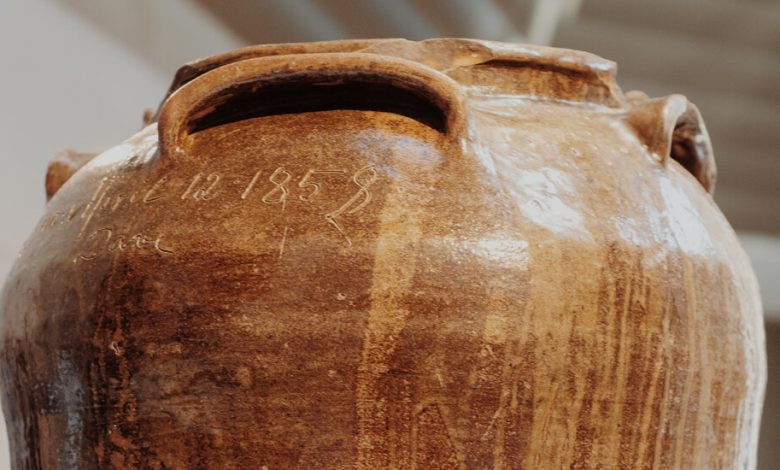The Magnificent Poem Jars of David Drake, Center Stage at the Met

At the center of “Hear Me Now: The Black Potters of Old Edgefield, South Carolina,” a revelatory exhibition at the Metropolitan Museum of Art, stands a majestic artifact: a stoneware storage jar that may qualify as one of 19th-century America’s great sculptures. It measures over two feet high, with a slightly rippling surface layered with drips of glaze in contrasting earth tones, from deep umber to ocher.
Elegantly proportioned, it swells out and up from a sturdy foot and then angles inward to form a shoulder with four ear-like handles to indicate that lifting it could be a considered, cooperative effort. It is possible to think of the jar as a monument, or memorial. Unlike the bronze equestrian variety dedicated to kings, conquerors and colonels since the Renaissance, however, it does not narrate history as much as contain it. In this regard it is something of a sacred object.
The jar, from the collection of the Crystal Bridges Museum of American Art in Bentonville, Ark., was created by a man now called David Drake, but who was known for decades only as Dave the Potter or Dave. A gifted enslaved artisan, Dave was admired during his lifetime for his skill and strength. He worked big, and his largest jars, like this one, started on the potter’s wheel but had to be completed by hand, using the coil method. When he signed and dated this particular jar, in 1858, he was working in the Stony Bluff Manufactory in the Old Edgefield district of South Carolina, where the ground was rich in stoneware clays. Sometime after the Emancipation Proclamation, he relocated to Texas, where he worked in potteries formed by other freedmen from Edgefield. He died in the 1870s.
Drake’s signing and inscribing of his jars was an act of courage and defiance, since it was a crime for the enslaved to learn to read or write; the starting punishment was usually the amputation of a finger. (There is speculation that Henry Drake, Drake’s first owner, taught him these illicit skills or that he picked them up while working for Abner Landrum, a newspaper publisher who owned Pottersville Stoneware.)
Nonetheless, Drake persisted, inscribing sardonic aphorisms in extraordinary cursive flourishes, information about the pot, and moralistic poems to the world — including one where he asked after his wife and children, who were sold away following the death of Henry Drake.
In others, he sent words of subtle encouragement to those who shared his predicament. On the Crystal Bridges jar his inscription suggests a ritual of gratitude for both the vessel and the gallons of food it would preserve: “A very Large Jar which has 4 handles = / pack it full of fresh meats — then light candles —/ Lm April 12 1858 / Dave.” (Lm stands for Lewis Miles, one of his owners.)
The words are especially poignant because jugs of this sort were often used to store meat for enslaved people. In these inscriptions, Drake also spoke to the future, memorializing — as artists tend to — his own existence, along with the personal oppression and the artistic independence that produced such remarkable creativity. Like most of his work, the jar, one of the largest Drake would make, combines aspects of a message in a bottle and the Liberty Bell.
The show at the Met is a regional landmark. Organized with the Museum of Fine Arts, Boston — curated by Adrienne Spinozzi of the Met, Ethan Lasser of the Boston museum and Jason Young, a historian at the University of Michigan — it is the first museum exhibition in the Northeast to explore the work of Drake and other enslaved potters (their names still unrecorded) who worked in the two dozen potteries operating in the Old Edgefield area through much of the 19th century. Enslaved people were involved in every aspect of ceramic production.
For decades Drake was known primarily in South Carolina, where his pots began to be discovered just after World War I by antique lovers and museum curators who were initially intent on recording the state’s visual culture. Especially important was Laura M. Bragg, who became the director of the Charleston Museum in 1920, and conducted the first amateur archaeological surveys of the Edgefield area and the first interviews with surviving potters. By 1930 she had matched Dave’s signature with that of a David Drake in a voter registry.
Drake’s first solo exhibition was likely at the McKissick Museum at the University of South Carolina, in 1998. His work was largely unknown to the contemporary art world until about 2010, when the artist Theaster Gates, who trained as a potter and is not shy about self-promotion, staged “To Speculate Darkly: Theaster Gates and Dave the Potter” at the Milwaukee Art Museum.
The Met’s show is ambitious, with a lot of moving parts that don’t always sync up. One problem is that it is being presented in (skylights aside) one of the museum’s worst exhibition spaces — the Robert Lehman Wing. It begins with a jaw-dropping display of a dozen “poem” jars and jugs signed or inscribed by Drake in what is basically a wide hallway, not really a gallery at all. Their consistency in terms of scale and volume, and variety of glazes, give a glimpse of Drake’s greatness without revealing its full range, especially in terms of glazing. An outstanding example here is a jug with a marvelous beer-foam slurp of white flowing down one side.
The interior gallery containing the show’s second act is crammed with so many different parts that the paucity of space becomes glaringly apparent. Displayed here are 16 vessels by mostly unrecorded Black artists, in vitrines pushed against the walls. Two of them are attributed to Thomas M. Chandler Jr., a white itinerant potter, and are distinguished by looping lines or swags in black iron slip oxide that also appear on vessels made by unrecorded artists working in two of the potteries he owned. Chandler also probably made a spectacular water cooler on which is depicted a Black man and woman in fancy dress — perhaps a wedding.
Also on view here are 19 examples of the fierce face jugs, known for their exaggerated features, grimacing teeth and wild eyes, that enslaved potters made for themselves — sometimes, it is believed, as tombstones. These should have had much more space. The inability to examine much of the 19th-century material in the round here is beyond frustrating.
As it is, the contributions of Drake’s contemporaries are shunted into half the gallery by the inclusion of works by five contemporary Black artists — Gates, Simone Leigh, Woody De Othello, Robert Pruitt and Adebunmi Gbadebo — mostly in ceramics. Their presence is enlightening, but visually discordant, especially in scale. With the exception of Gbadebo — who works with clay gathered from the cemetery of the South Carolina plantation where members of her family were enslaved — these artists are current art-market favorites, which lacks curatorial initiative. A work by Jim McDowell, a ceramic artist based in Weaverville, N.C., who makes face jugs, could have been included (as suggested by his 2020 piece reproduced in the catalog). And the contemporary works should have had their own gallery, as was the case with the Met’s recent Winslow Homer retrospective, “Crosscurrents.”
Shortcomings aside, this show is a gift. It introduces Drake, a great artist, to a larger audience, anointing him a hero for contemporary ceramics and art and a formidable exemplar of the nearly universal tradition of storage jars down through the ages — well represented in the Met’s holdings. His is the latest Black achievement — whether of the past or the present — to sweep through American life, history and culture, a new broom that will not be denied.
Hear Me Now: The Black Potters of Old Edgefield, South Carolina
Through Feb. 25, 2023, at the Metropolitan Museum of Art, 1000 Fifth Avenue, Manhattan, (212) 535-7710; metmuseum.org.




